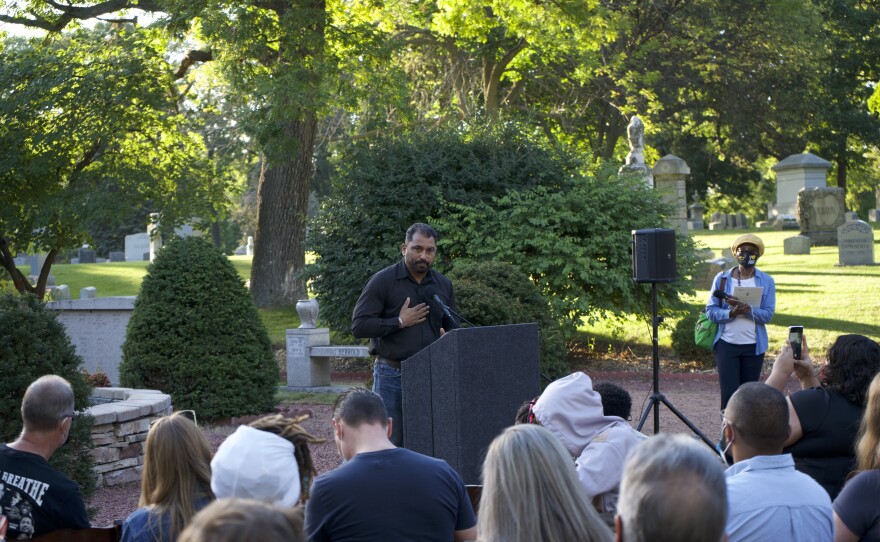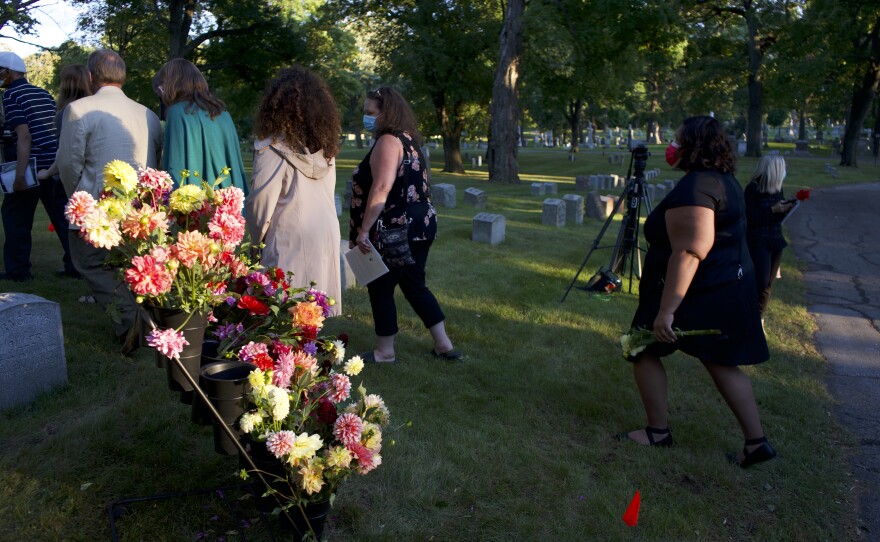On September 6, 1861, 24-year-old George Marshall Clark and another Black man, James Shelton, were arrested after an altercation with two white men, Dabney Carney and John Brady.
The fight ended after Shelton stabbed Carney and slashed Brady. Carney identified Shelton as his assailant before he died the next day.
A white mob stormed the city jail soon after Carney's death. On September 8, as Shelton hid, Clark was abducted and lynched in Milwaukee’s Third Ward on the corner of Water and Buffalo streets. After his body was cut down, he was taken to Forest Home Cemetery and buried in an unmarked grave in a public lot.
160 years later, on September 8, 2021, the burial site finally was marked with a proper headstone thanks to the efforts of local artist and activist Tyrone Randle, Jr. and Forest Home Cemetery.
"It kind of stirs me a little bit to see this many bodies out here who care about the education behind this," said Randle, as he looked out to the crowd of about 100 people gathered at the cemetery.

Randle first researched George Marshall Clark in the summer of 2020, along with his partner Aadya Wynter, when they were planning a march to the grave site. However, when they discovered Clark’s grave was unmarked, it became Randle’s mission to raise the funds needed to memorialize Clark with a headstone.
"It's easy to just act like something doesn't exist if you can't see it. So the fact that it's tangible...that actually happened. I can go and I can say, like, that's a body in the ground," Randle noted. "I think people need to be able to see that."
Forest Home Cemetery sales counselor Garen Morris was working the day that Randle was trying to find Clark’s burial site. Together, they combed through internment records and physically mapped out where the grave was located.
READ: ‘It’s About Healing’: Activist Works To Memorialize Milwaukee’s Only Black Lynching Victim
"I hate to put it as any grave that finally gets marked makes me feel good, but to know that this is one that has a huge historical value to the community, to this cemetery, and to our peace of mind to know that next time we want to find this, it's going to be easy," said Morris. "And that headstone is just a small piece of telling a story."
Randle and Morris said it was a stressful process to make sure they could dedicate a headstone in time for the anniversary. Among some of the last-minute changes was the material used: American black granite.
"Maybe it's even accidental, but 'American black' that sounds pretty fitting, right, for the situation. So I think that was pretty cool," said Randle.
Morris added that they also discovered that the granite used for the headstone was quarried from Clark's home state of Pennsylvania.
The ceremony to unveil Clark's headstone was held by Forest Home Cemetery and America’s Black Holocaust Museum. Community leaders, historians and activists were among those gathered in the cemetery’s Victorian Garden on a clear afternoon, surrounded by countless trees and headstones, large and small.

America’s Black Holocaust Museum President & CEO Dr. Robert Smith said that while it’s painful to go over this brutal event, it’s important.
“The thing about history and telling the truth about history is it brings about a certain amount of understanding and dignity, quite frankly," he said. "And so now [George Marshall Clark's] story is being told, and so it would hopefully spark some curiosity with especially some of our younger generations to say, what else have we not been told?"
Educator and public historian Reggie Jackson was one of the speakers for the unveiling and memorial. For him, it was important that the community memorialize Clark the man, not the lynching victim.
“Let's think of what we're doing for George Marshall Clark tonight, not being a celebration of the fact that we're acknowledging this lynching. But then we're celebrating his life that was ended by that lynching,” Jackson said.
Jackson said that Clark was, from all accounts, a well-liked young man in the community. He was learning to become a barber under his father George, who owned a barber shop in Milwaukee. Jackson also noted that Clark’s life intersected with an interesting time in our state’s history.
Wisconsin was a free state with a unique abolitionist attitude, refusing to enforce the Fugitive Slave Act. The rescue of Joshua Glover, a Black man who escaped slavery in St. Louis to freedom in Racine in 1852, was a testament to this.
READ: Milwaukee Black History: How Joshua Glover's Rescue Contributed To The Repeal Of Fugitive Slave Act
"Now, can you imagine being a Milwaukeean and at that time, being a city that had celebrated a group of citizens who went into Milwaukee to free a Black man who had been wrongly jailed in the Milwaukee County Jail, a story that we all celebrate. Yet, just a few years later, a different group broke into that same jail with completely different intentions," noted Jackson.

Jackson said Clark’s lynching is a stain on Milwaukee’s history that isn’t widely known.
"Students in Milwaukee don't learn the story of George Marshall Clark's lynching...It's time we start teaching all of them that beginning today...We have to understand the racial animus that led to that fight, and the racial animus that led to the lynching. It's still alive and well today unfortunately, 160 years later," Jackson said.
Jackson continued, "We need to embrace the diversity of our community, so that we can begin to work on not necessarily racial repair and reconciliation, but conversations that lead to racial repair and reconciliation…I know that if George Marshall Clark were here today, he would say something along these lines: 'I'm really sad that things have not changed as much as they should have in the last 160 years.'"
Interfaith Conference of Greater Milwaukee executive director Pardeep Singh Kaleka called for justice and healing — and for people to reflect on the ways they perpetuate racial injustice today.
"It is well understood that our country has its roots in racialized religious and ethnic violence. Our foundational dirt is so soiled in bloodshed, that it's a wonder that grass still grows, and trees still blossom," he said. "But they do. And so do Black families, so does Black love, and so does Black brilliance. But that does not mean that we can ignore Black pain, nor be absolved of our own responsibility in causing it.”
After remarks concluded, participants walked from the Victorian Garden to Section 17 of Forest Home Cemetery to gather around Clark’s gravesite. Tyrone Randle stood behind the headstone, which was covered in an emerald cloth.
“I’m emotional. I’m happy, but I'm also at a place where I know that this work's not done. There are a lot more Black figures who have done great work who are still left unnoticed, and I think that is something that needs to change. It's something that is important for Black kids to have heroes to look up to, especially in this city...I'm happy that this has come to a conclusion for Marshall, and the work’s not done, y'all," said Randle.
The cloth was pulled away, showing a black granite headstone that reads:
George Marshall Clark
July 1st, 1837
September 8th, 1861
Dedicated on September 8th, 2021
Lest We Forget
The marker was blessed, and each person at the ceremony laid a flower at the headstone, finally paying respect to a man’s life taken.




















